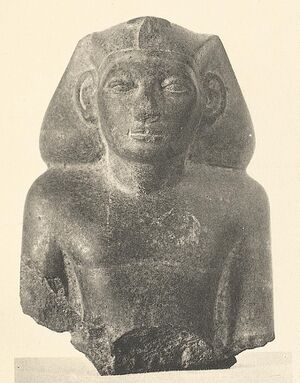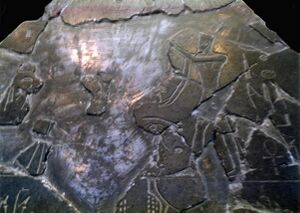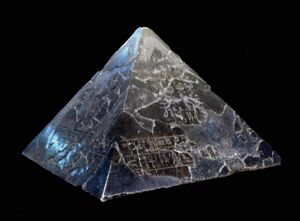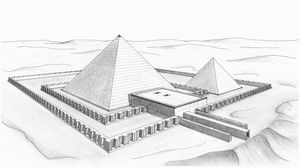أوسر كا رع خنجر
| Khendjer | ||||||||||||||||||||||||||||||||||||||||
|---|---|---|---|---|---|---|---|---|---|---|---|---|---|---|---|---|---|---|---|---|---|---|---|---|---|---|---|---|---|---|---|---|---|---|---|---|---|---|---|---|
 Upper part of a statue of Khendjer from his pyramid complex. Cairo Egyptian Museum, JE 53368 | ||||||||||||||||||||||||||||||||||||||||
| فرعون مصر | ||||||||||||||||||||||||||||||||||||||||
| الحكم | Five years starting in 1764, 1756 or 1718 BC, Thirteenth Dynasty of Egypt | |||||||||||||||||||||||||||||||||||||||
| سبقه | Wegaf (most likely[1]) or Khaankhre Sobekhotep | |||||||||||||||||||||||||||||||||||||||
| تبعه | Imyremeshaw | |||||||||||||||||||||||||||||||||||||||
| ||||||||||||||||||||||||||||||||||||||||
| القرينة | Sonb[henas] | |||||||||||||||||||||||||||||||||||||||
| المدفن | Saqqara, Pyramid of Khendjer | |||||||||||||||||||||||||||||||||||||||
أوس كا رع خنجر بالإنجليزية Khendjer ، هو الفرعون الخامس في الأسرة الثالثة عشر في عهد الدولة الوسطى. [2].[3] Khendjer possibly reigned for four to five years, archaeological attestations show that he was on the throne for at least three or four years three months and five days. Khendjer had a small pyramid built for himself in Saqqara and it is therefore likely that his capital was in Memphis.
. . . . . . . . . . . . . . . . . . . . . . . . . . . . . . . . . . . . . . . . . . . . . . . . . . . . . . . . . . . . . . . . . . . . . . . . . . . . . . . . . . . . . . . . . . . . . . . . . . . . . . . . . . . . . . . . . . . . . . . . . . . . . . . . . . . . . . . . . . . . . . . . . . . . . . . . . . . . . . . . . . . . . . . .
الترتيب الزمني


The exact chronological position of Khendjer in the Thirteenth Dynasty is not known for certain owing to uncertainties affecting earlier kings of the dynasty.
Turin King List
The Turin King List mentions Khendjer in between Sekhemre Khutawy Sobekhotep and ...kare Imyremeshaw.[4]
7:19 The Dual King Sekhemre Khutawy Sobekhotep reigned x years ...
7:20 The Dual King Userkare Khendjer, x years ...
7:21 The Dual King ...kara Imyremeshaw, 4 days
Theories
Egyptologist Darrell Baker makes him the twenty-first king of the dynasty, Ryholt sees him as the twenty-second king and Jürgen von Beckerath places him as the seventeenth pharaoh of the dynasty. Furthermore, the identity of his predecessor is still debated: Baker and Ryholt believe it was Wegaf, but that pharaoh is confused with Khaankhre Sobekhotep, so that it is not known which one of the two founded the Thirteenth Dynasty and which one was Khendjer's predecessor.[1][3]
Reign
The highest attested date for Khendjer's reign is the fourth month of the season of the Inundation), day 15 in his fifth regnal year. Kim Ryholt notes that two dated control notes on stone blocks from his unfinished pyramid complex give him a minimum reign of 3 or 4 years 3 months and 5 days.[5] The aforementioned control notes are dated to Year 1 I Akhet day 10 and Year 5 IV Akhet day 15 of his reign.[6] In these control notes, the names of three officials involved in building the pyramid are also identified. They are the chamberlain of the palace, Senebtyfy, the chamberlain Ameny and the chamberlain, Shebenu.[7] The latter is also attested by other sources.[8]
Several absolute dates have been proposed for his reign, depending on the scholar: 1764—1759 BC as proposed by Ryholt and Baker,[1] 1756—1751 BC as reported by Redford,[9] and 1718—1712 BC as per Schneider.[10]
Attestations
Khendjer is known primarily from his pyramid complex excavated by G. Jequier at Saqqara which was perhaps completed as a pyramidion was found.[11] There was found a fragment of a canopic jar, which offers a partial name for his queen, Seneb ... "which may be restored as Sonb[henas]."[12]
Other objects with the name of the king are a stela from Abydos recording building projects by the king at the Osiris temple at Abydos, and naming the vizier Ankhu. Another stela once in Liverpool (destroyed in World War II), provides the name of the king's son "Khedjer". He might be a son of the king.[13] Other objects with his name, according to the list provided by Ryholt, include three cylinder-seals from Athribis, a tile found near el-Lisht, scarab seals and an axe blade.
Theories
The name Khendjer is poorly attested in Egyptian.[14] Khendjer "has been interpreted as a foreign name hnzr and equated with the Semitic personal name h(n)zr, [for] "boar" according to the Danish Egyptologist Kim Ryholt.[1] He notes that this identification is confirmed by the fact that the name h(n)zr is written as hzr in a variant spelling of this king's name on a seal from this king's reign.[15] Ryholt states that the word 'boar' is:
- attested as huzīru in Akkadian, hinzīr in Arabic, hazīrā in Aramaic, hazīr in Hebrew (the name is attested as hēzīr in I Chron. 24:15, Neh. 10:20) hu-zi-ri in the Nuzi texts, hnzr in Ugarit, and perhaps hi-zi-ri in Amorite.[1]
Khendjer could be, according to this theory, the earliest known Semitic king of a native Egyptian dynasty. Khendjer's prenomen or throne name, Userkare, translates as "The Soul of Re is Powerful."[16]
Khendjer, however, may have had a second prenomen at his coronation: 'Nimaatre' which translates as 'The one who belongs to Maat is Re.'[17] This name appears together with the name Khendjer at the top of the stela of Amenyseneb (Louvre C11).[18]
مدة الحكم
من ملاحظات الإدارة على أحجار هرمه الذي لم يكتمل، فقد أرخ كيم رايهولت له مدة حكم حوالي أربع سنوات وثلاثة أشهر وخمس أيام.[19]
تأريخ
| العهد | الأسرة | سنوات الحكم |
| الدولة الوسطى | الأسرة الثالثة عشر | من 1760 ق.م. إلى 1740 ق.م. ± 30 سنة |
| الكاتب | سنوات الحكم |
|---|---|
| ريهولت | 1764 ق.م. - 1759 ق.م. |
| ردفورد | 1756 ق.م. - 1751 ق.م. |
| كراوس | 1718 ق.م. - 1712 ق.م. |
| فرانكه | 1718 ق.م. - 1712 ق.م. |
| سبقه: سوبك حوتـپ الثاني |
فرعون الأسرة الثالثة عشر (1770 ق.م.) |
لحقه: سوبك حوتب الثالث |
انظر أيضا
المصادر
- ^ أ ب ت ث ج K.S.B. Ryholt: The Political Situation in Egypt during the Second Intermediate Period, c.1800–1550 BC, Carsten Niebuhr Institute Publications, vol. 20. Copenhagen: Museum Tusculanum Press, 1997
- ^ الاسم خنجر Khedjer كإسم خاص للأفراد ظهر فقط على تمثالين : Stela Marischal Museum, University of Aberdeen ABDUA 21642 and on stela Liverpool M13635, see Ian Ralston: The Stela of Ibi son of Iiqi in the Marischal Museum, University of Aberdeen, In Discovering Egypt from the Neva, The Egyptologcial Legacy of Oleg D Berlev, edited by S. Quirke, Berlin 2003, p. 107-110, pl. 6 and W. Grajetzki: Two Treasurers of the Late Middle Kingdom, Oxford 2001, p. 28, pl. 2. Both monuments date to around the time of king Khendjer and the individuals there might have called themself after the king.
- ^ أ ب Darrell D. Baker: The Encyclopedia of the Pharaohs: Volume I - Predynastic to the Twentieth Dynasty 3300–1069 BC, Stacey International, ISBN 978-1-905299-37-9, 2008, p. 181
- ^ "Turin king list: Column 7".
- ^ Ryholt, p.193
- ^ Ryholt, pp.193-195
- ^ Felix Arnold: The Control Notes and Team Marks, The South Cemeteries of Lisht, Volume II, New York 1990, ISBN 0-87099-551-0, pp.176-183
- ^ "Marks and notes in the Pyramid Complex of Khendjer | Persons and Names of the Middle Kingdom".
- ^ Redford, Donald B., ed. (2001). "Egyptian King List". The Oxford Encyclopedia of Ancient Egypt, Volume 2. Oxford University Press. pp. 626–628. ISBN 978-0-19-510234-5.
- ^ Thomas Schneider following Detlef Franke: Lexikon der Pharaonen
- ^ G. Jequier: Deux pyramides du Moyen Empire, Cairo 1933, S. 3-35
- ^ Ryholt, op. cit., p.221 The object is Cairo JE 54498
- ^ W. Grajetzki: Two Treasurers of the Late Middle Kingdom, Oxford 2001, p. 28, pl. 2
- ^ The name Khedjer for private individuals appears on only two monuments: Stela Marischal Museum, University of Aberdeen ABDUA 21642 and on stela Liverpool M13635, see Iain Ralston: The Stela of Ibi son of Iiqi in the Marischal Museum, University of Aberdeen, In Discovering Egypt from the Neva, The Egyptologcial Legacy of Oleg D Berlev, edited by S. Quirke, Berlin 2003, pp.107-110, pl. 6 and W. Grajetzki: Two Treasurers of the Late Middle Kingdom, Oxford 2001, p. 28, pl. 2. Both monuments date to around the time of king Khendjer and the individuals there might have called themselves after the king.
- ^ Ryholt, p.220 and footnote 763
- ^ Peter Clayton, Chronicle of the Pharaohs, Thames and Hudson Ltd, 2006 paperback, p.91
- ^ Khendjer Titulary Archived 2012-05-27 at the Wayback Machine
- ^ Jürgen von Beckerath: Untersuchungen zur politischen Geschichte der zweiten Zwischenzeit in Ägypten, Glückstadt 1964, 238
- ^ Ryholt, op. cit., p.193


